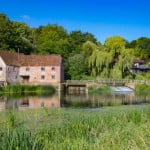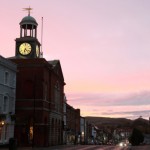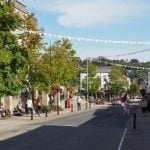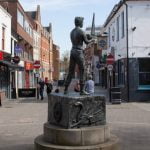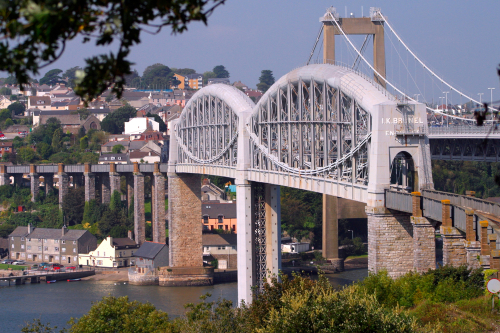
A quick guide to Saltash
Saltash is a market town and civil parish in southeast Cornwall, southwest England. It lies opposite Plymouth on the west bank of the Tamar Estuary, close to its confluence with the Lynher River. Known as “the Gateway to Cornwall”, Saltash is perhaps best known for the 668 m long Royal Albert Bridge, a railway viaduct spanning the River Tamar, that was constructed by Isambard Kingdom Brunel in the 1850s. At the time of the 2011 national census, Saltash’s population was recorded as 16,184.
A Fleeting History
Early Times
Little is known of the ancient history of Saltash but it seems certain that the Saxons established a manor at Trematon in the 8th century. The Saxon King Athelstan, who ruled the area during the first half of the 10th century is thought to have built a fort at the site where Trematon Castle now stands. Following the Norman Conquest of 1066, Robert, the Count of Mortain, half-brother of William the Conqueror, was granted the manor at Trematon. He chose to build his castle just southeast of Trematon Village, overlooking the Lynher estuary. The castle became the area’s seat of power and Robert quickly established a weekly market around the entrance to the structure.
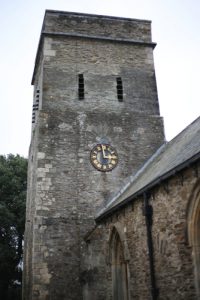
St Stephen’s Parish Church, Saltash dates back to the 11th century
In 1075, the Manor of Trematon passed from Robert to Richard de Valletort, a knight who had fought at the Battle of Hastings. Richard founded a borough in the vicinity of the castle and then built a new parish church, dedicated to St Stephen, on the high ground across the valley from the castle. Circa 1190, with a failing borough and market, Richard decided to re-establish them nearer to the foreshore of the Tamar estuary. The new settlement boundaries that were laid out included an existing community of fishermen and ferrymen.
By 1201, the new Borough of Esse was a well-established market town and seaport. While Esse was a Norman family name, originating from those who reside near an ash tree, there seems to be uncertainty as to just whom or what the ‘Esse’ name at Saltash may have referred.
The 14th & 15th Centuries
Over time, the town’s name transmuted from ‘Esse’ to ‘Asshe’. Later, the prefix ‘Salt’ was added to distinguish it from other places in the area with similar names. The prefix is thought to denote the town’s location on the shores of the ‘saltwater’ estuary of the River Tamar. In 1300, Edmund of Almain, the 2nd Earl of Cornwall, died without an heir so the Manor of Trematon passed to the Crown. In 1337, Edward III created the Duchy of Cornwall for his eldest son, Prince Edward, who later would be famously dubbed the ‘Black Prince’ – due to the colour of his armour. While Prince Edward was never to take up residence at Trematon, he held the manor up until 1372 when he bestowed it to Sir Nigel Loring. In the late 14th century, Richard II endorsed Saltash’s charter and granted the revenue from local ferryboat crossings to the town’s mayor and burgesses (town officials) for a term of 30 years.
Through the 15th century, Saltash continued to develop as a port. It was the first to be established on a local estuary that reached far inland from Plymouth Sound. By now, the town had also built up a great reputation for shipbuilding. Consequently, the manor of Saltash was granted jurisdiction over all local waters, with the rights to operating the local ferry, the fisheries and the collecting dues for anchorage, buoyage, barges, etc. being leased to the burgesses of Saltash.
By 1439, Saltash had been eclipsed by the development of Plymouth, but it did not lose its local significance. A charter was only granted to Plymouth on the condition that it should not interfere with the Borough of Saltash or its rights over the Tamar. Eventually, Saltash’s prescriptive marine rights fell under one jurisdiction, which became known as the Liberty of the Water Tamar. The arrangement was challenged many times over the centuries but was not completely terminated until 1901.
The 16th & 17th Centuries
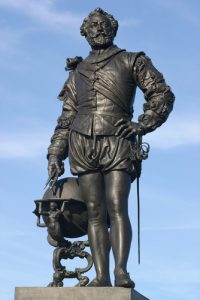
Francis Drake landed his haul of Spanish treasure at Saltash
In 1580, Francis Drake returned from his great voyage around the world, carrying huge quantities of gold plundered by the Spanish. His ship, the Golden Hind, was brought up the Tamar, and its treasure unloaded for storage at Trematon Castle, before arrangements could be made for it to be transported to the Tower of London. By the beginning of the 17th century Saltash comprised between 80 and 100 houses. By now, the docklands were so busy that a new quay had to be built. Sand Quay was initially used for the unloading of barges that were carrying sea sand, but later on for ship and boat building
Due to its important strategic position Saltash played a major role during the English Civil War of 1642 – 1646. Saltash, like most of Cornwall was staunchly royalist and one of the last areas to fall to Cromwell’s army. The town was constantly under attack from its Parliamentarian neighbour Plymouth. Saltash changed hands at least eight times during the 4-year war, sustaining a great deal of damage. The Saltash Royalists were finally defeated in 1646 when Ince Castle, their last stand, finally fell to Parliamentarian forces. The population of Saltash which had stood at 1,137 in 1641, fell to 900 immediately after the war.
The 18th & 19th Centuries
In 1724, famed author, journalist and traveller, Daniel Defoe, passed through Saltash, describing it as “a little, poor shattered town”. However, by the 1750s Saltash was flying high once again when its shipyards were commissioned by the Admiralty to built two sloops for the Royal Navy at Plymouth. It was during this time that Saltash began to develop beyond the boundaries of its original medieval plan when large villas where built close to the Fore Street area. However, in 1791, a serious blow to the town’s economy was struck with the opening of the Torpoint ferry. The new ferry housed its Devon terminus closer to the centre of Plymouth than that of the Saltash service, thus diverting a great deal of trade away from the town.
By the early 19th century other industries such as market gardening, quarrying and tanning were all flourishing in the borough. In 1801, the population of the borough rose was 1,150 but by 1831 it had rose to 1,637. In 1859, Saltash’s famed 667 m long Royal Albert Bridge, designed and built by Isambard Kingdom Brunel was completed at a cost £230,000, the equivalent of more than £25 million, today (2020).
The 20th Century
On the 1st of January 1886, The Liberty of the Tamar was finally terminated when a royal charter created the Municipal Borough of Saltash and a borough council. However, the collection of dues from the Liberty was permitted until 1901. The Council then sold its long-held rights over local waters to the Admiralty. In the 1890s, Saltash got piped water as well as its first police station. By 1901, the population of Saltash was 3,357.
In 1918, Wearde Army Training Camp was converted to Queen Alexandra’s Convalescent Centre, caring for casualties from WW1. Almost a hundred servicemen from Saltash lost their lives during the conflict. In 1934, the area of the Borough of Saltash was greatly increased from around 200 hectares to some 2,000 hectares to take in the Parish of St Stevens and the Manor of Trematon. In April 1941, the Luftwaffe tried to bomb the vital Royal Albert Bridge. They missed their target but hit the town instead, killing 7 people and destroying some 20 important buildings.
The Modern Era
In October 1961, the Tamar Bridge was opened to traffic meaning that the ferry that had operated for almost 400 years became immediately redundant. Her Majesty Queen Elizabeth, the Queen Mother officially, officially opened the Tamar Bridge on the 26th of April 1962. The opening of the road bridge saw Saltash develop enormously during the 1960s, with subsequent growth in population.
The biggest changes took place along the waterfront when in 1957, the old industrial area was declared a slum. A decision was made to demolish all but two of the area’s historic buildings, some of which dated from the 16th century. It took some 9 years to complete the project with the district being predominately converted to a residential and leisure area. Another major change for Saltash came in 1988 when the A38 bypass of the town was completed. In 2000, the Saltash Museum and Local History Centre was opened, and, in 2001, the Saltmill Park sports facility.
Today, Saltash has a mixed economy, although like much of the UK, the service industry is fairly dominant. However, agriculture, construction, manufacturing, technology and tourism sectors all make up a good proportion of the town’s economy. Saltash’s local food market is held on the first Monday of every month on Fore Street between 10 am-2 pm.
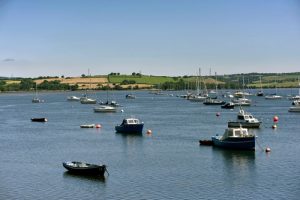
A view of the Tamar Estuary from Saltash waterfront
Getting there!
By Road
It’s straightforward and easy to get to Saltash by road. Just take the M5 to Exeter, keeping straight on for the A38. After about 40 miles you’ll cross the Tamar Bridge, which will see you arriving in both Saltash and Cornwall.
By Rail
The main Plymouth to Penzance line offers regular services to Saltash and the rest of Cornwall. First Great Western operate services from Paddington, London and South Wales. From London there’s an hourly service operating between 6 am and 7 pm.
By Bus
National Express operates express coach services to Plymouth from departure points from all over Britain. These include regular services from London Victoria and Heathrow Airport.
By Air
The nearest airport to Saltash is Newquay Airport which and is 35 miles away and has frequent services from London. The nearest large international airport is Bristol which is 95 miles away.
Annual Events
Saltash May Fair is a full day of outdoor entertainment that takes place in and around Fore Street, Longstone Park and Victoria Gardens and takes place during early May.
Saltash Regatta takes place along the waterfront area in summertime each year and is one of Cornwall’s most popular events. On the water, the entertainment includes gig racing, sailing, canoeing and swimming. Ashore there’s the usual festival stalls, music and marquees.
Saltash Christmas Festival takes place in early December and is a showcase for the town’s retailers, especially those on Fore Street. Street entertainment, music and fireworks are also on the menu.
Did you know?
- Designer of the Royal Albert Bridge, celebrated engineer Isambard Kingdom Brunel was to ill to attend the grand opening of the structure carried out by Prince Albert on 2nd May, 1859. He died just 3 months later.
- On 6th of August 1914, HMS Amphion became the first ship of the Royal Navy to be sunk during WWI. The fatalities included two Saltash sailors.
- In 1973 Saltash shopkeeper Frank Elliott was so aggrieved by changing times and the UK’s recent decimalisation that he decided to close his shop. No big deal you might think. However, the shop is still as it was in 1973 with all the goods still on the shelves. It’s now a small museum that is open to the general public.
Sport
Saltash FC
Saltash United Football Club is a semi-professional football club that plays in the South West Peninsula League Premier Division West. Nicknamed ‘The Ashes’, they play their home games at Kimberley Road, which has a capacity of around 3,000.
Caradon Pilot Gig Rowing Club
Saltash is the home of Caradon Pilot Gig Rowing Club. A Cornish pilot gig is a six-oared rowing boat especially built for sea conditions.
Things to see and do!
- Antony House & Woodland Gardens – is an outstanding early 18th-century mansion with fine gardens set in parkland. It’s located near Torpoint across the Lynher estuary about 16 miles from Saltash by road.
- Mount Edgcumbe House and gardens – is a grand country house set in almost 350 hectares of Country Park. Located on the Rame Peninsula near Torpoint, the estate has a 500-year history.
- Royal Albert Bridge – is a 667 m long Victorian railway bridge that spans the River Tamar between Plymouth and Saltash. Opened in 1859, the structure was designed by Isambard Kingdom Brunel is still regarded by many as one of the world’s greatest bridges.
- Cotehele Mill – is a working flour mill dating from Medieval times. Amongst other things, there’s a giant waterwheel, artisan workshops and a horse-drawn hay rake. The mill is run and operated by the National Trust.
- Cotehele House and Gardens – is a Tudor house with Medieval roots, apart from its working mill, it has a historic quay, celebrated garden, great valley views, and an expansive estate.
- Elliott’s Shop Museum – is situated opposite Saltash Guildhall in Lower Fore Street. The shop has been perfectly restored and preserved to the way it was throughout much of the 20th century. The life of the Elliot family and Saltash is told through family photos, letters, slides, and other artefacts. The museum is run by distant family members and other volunteers.
- Trematon Castle – is located 2 miles from Saltash and set on high ground, overlooking Plymouth Sound. There are great views and fantastic gardens. Although owned by the Duke of Cornwall, its currently occupied under a private leasehold. Its open to the public from Thursdays to Saturdays.
- Saltash Museum & Local History Centre – is a small permanent display about the history and locally famed people of Saltash. It’s open on Wednesdays and Saturdays 10 am – 4 pm, with longer opening times in Summer.
Where to stay?
There is quite limited availability of accommodation in Saltash itself. The commonest type of accommodation within several miles of Saltash are hotels that fall in the £80 – £130 per night price range. A little further away, Plymouth provides a full range of accommodation with prices to suit all budgets.
Moving to Saltash?
Thinking of moving to Saltash? The average property price in the Saltash area for July 2020 stood at approximately £245,000. This represents a fall of about 5.5 % on the average price paid in the last 12 months. In terms of property types, flats were selling for an average of £135,700, terraced houses for £186,300 and semi-detached for £211,500.

